Reserve Bank of Australia Annual Report – 1985 Economic Developments[1] [2]
The International Economy
The industrial economies continued to expand over the course of 1984/85 and, as in the preceding two years, inflationary pressures remained subdued. Despite the achievement of growth with low inflation, a number of important problems continue. Unemployment in Europe persists at record levels. Significant budgetary and external imbalances also remain in some countries.
Real GDP in the OECD area is estimated to have grown by around 3.8 per cent in 1984/85, compared with growth of around 4.2 per cent in 1983/84. The slowdown in growth was quite marked in the United States. Growth of the Japanese economy, although slowing slightly, continued at a relatively high rate. Activity in Europe improved a little. Overall, the wide divergence between rates of growth in North America and Western Europe declined substantially, while Japan regained its position as the fastest growing of the major economies.
Slower growth in the OECD area during the year was dominated by developments in the United States. Changes in patterns of demand showed some similarities across countries. Private consumption and residential investment – which had been important elements in the initial stages of recovery in North America and the United Kingdom – tended to weaken, most notably in the second half of 1984. Towards the end of the year, there was evidence of stronger growth in consumption in the United States and, to a lesser extent, in Japan, the United Kingdom and West Germany. Business investment, while failing to sustain the exceptionally rapid growth rates achieved in some countries in 1983/84, continued to rise. The contribution from the external sector varied considerably across countries. The strength of the U.S. dollar, coupled with heavy demands on U.S. capital markets, was associated with a widening trade deficit. This contributed to the slowing in U.S. production despite continued strong growth in domestic demand. The balance of foreign trade added to growth in Canada, West Germany and Japan but detracted from it in the United Kingdom.
Employment growth generally weakened in 1984/85 in line with the slowing in economic growth, although there were signs that employment in Europe may have increased slightly after four years of decline. Near the end of 1984/85, unemployment in the OECD area was around 8.2 per cent, little changed from the preceding year.
Inflation rates remained stable or, in some cases, fell further in 1984/85. In the twelve months to May 1985, consumer prices in the OECD area rose by 4.8 per cent, a little below the increase in the preceding twelve months. This stability was accompanied by further convergence in rates of inflation. The subdued increase in prices over 1984/85 was helped by continued restraint in wage demands and generally depressed commodity prices, including that of oil.
9 International Economic Conditions
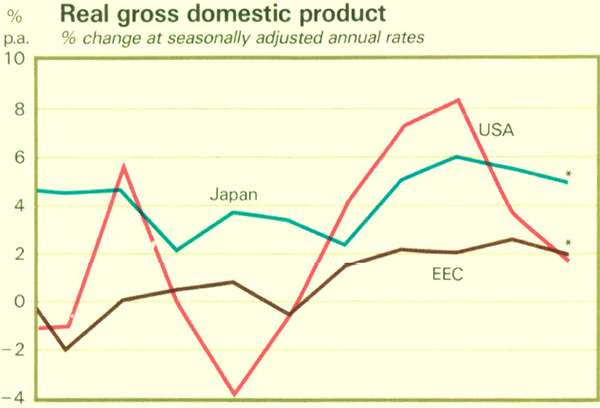
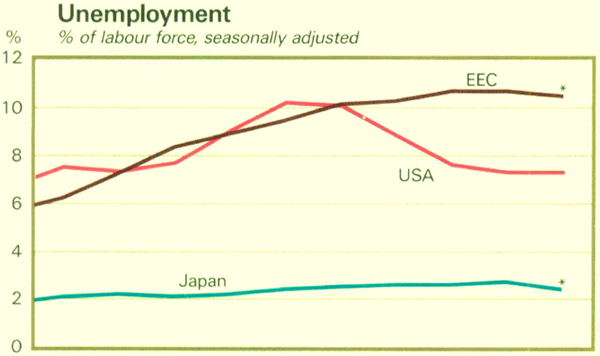
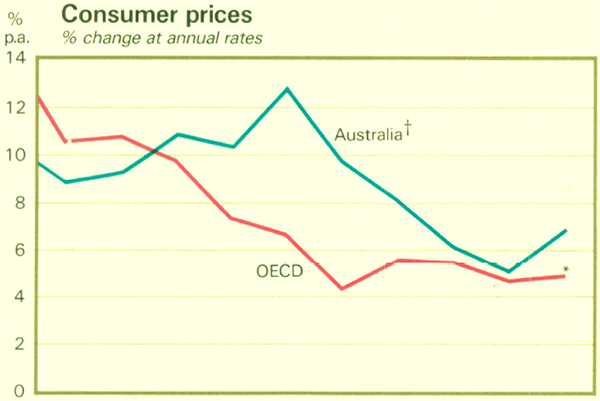
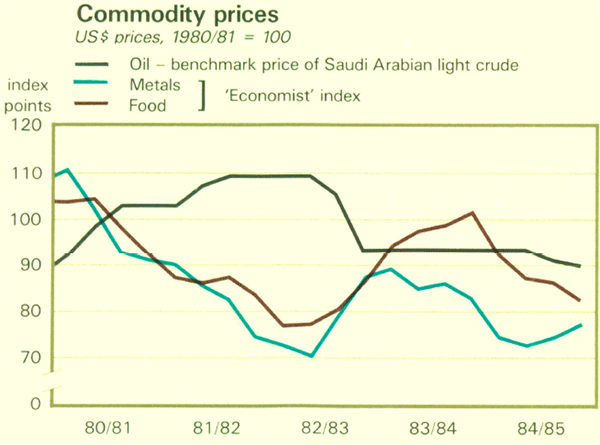
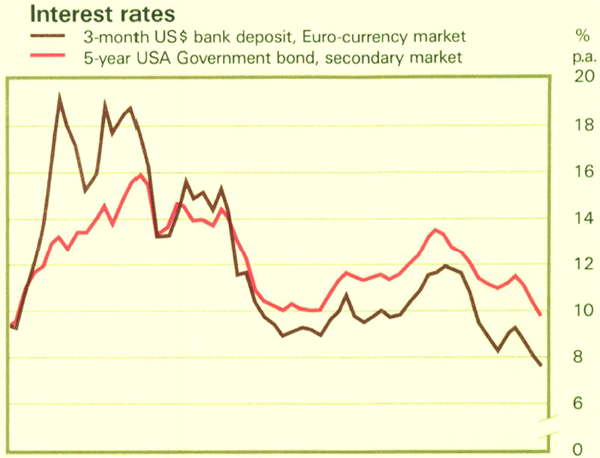
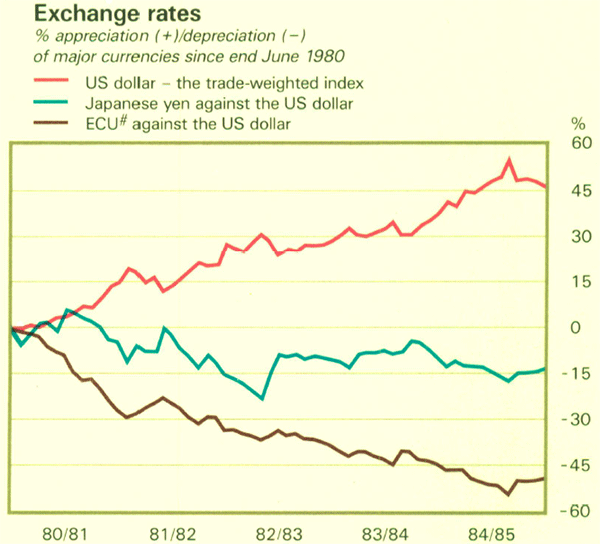
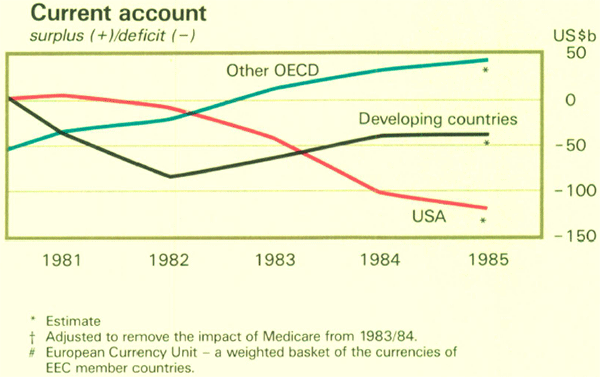
Over the year to June 1985, the ‘Economist’ index of non-oil commodity prices, expressed in U.S. dollars, fell by 12½ per cent. While the weakness of dollar prices partly reflected the strength of the U.S. currency, supply and demand factors were also important. In particular, in response to rising prices over 1983/84 and favourable seasonal conditions, production of most agricultural commodities rose in 1984/85, thereby depressing prices. Despite some increases in the first half of 1985, prices of metals remained depressed due to over-production. Efforts by OPEC members to stabilise the world oil market, including a reduction in production quotas in October 1984, proved largely ineffective in the face of price cuts by major non-OPEC producers. A reduction in official prices occurred in early 1985.
Despite the narrowing of growth differentials and an accompanying slowdown in the growth of world trade in 1984/85, the major external imbalances that had emerged within the OECD area over recent years remained. In particular, the current account deficit in the United States grew further and appears to have exceeded US$110 billion in 1984/85. Offsetting this has been a rise in the surplus in the rest of the OECD area, especially in Japan. The shift in the distribution of OECD current accounts in recent years has been accompanied by a substantial reduction in the combined current account deficit of the developing countries; in large part, this reflects the success of adjustment efforts undertaken since 1982.
Foreign exchange markets were again dominated by movements in the United States dollar. The U.S. currency continued to strengthen in the second half of 1984 and early 1985. By February, it had reached record highs against most major currencies and was at its highest levels in over a decade against others. Signs that the strength of the U.S. economy may have been faltering and renewed concern over the stability of the U.S. banking system combined to weaken the dollar from early March. By the end of 1984/85, the U.S. dollar, on a trade-weighted basis, was 8.2 per cent below the peak reached earlier in the year. Despite this reversal, the U.S. dollar was stronger against all major currencies at the end of June 1985 than it had been a year earlier.
Exchange rates were highly volatile during 1984/85 despite substantial central bank intervention on occasions. Reflecting concern over swings in exchange rates, the Finance Ministers and central bank Governors of the Group of Five reaffirmed in mid January their commitment to co-ordinated intervention in foreign exchange markets to counter disorderly conditions. This announcement and moderate intervention in the latter part of January seemed temporarily to ease upward pressure on the U.S. dollar. A subsequent resurgence of the dollar prompted more concerted intervention in late February; this helped reverse the dollar's advance.
A feature of economic policy in major countries in recent years has been the high priority accorded to price stability. In 1984/85, monetary policy initiatives were influenced by the state of economic activity, interest rate movements and, in some cases, exchange rate movements more than had been the case in recent years.
In the United States, pressures on financial markets eased from around September 1984, in the face of a strong dollar and slower growth in monetary aggregates and the economy in general. Interest rates, which had begun to decline from around mid 1984, fell more rapidly towards the end of 1984. Following a rise in early 1985, rates again declined steadily. In most other countries, short-term interest rates remained relatively stable. However, in some, most notably the United Kingdom and Canada, rates rose in early 1985 in response to efforts to shore up their depreciating currencies. Longer-term rates generally continued on a modest downtrend. While lower money supply targets were adopted for 1985 by the United States, United Kingdom, West Germany, Italy and France, monetary growth in the first half of 1985 was above target in some of these countries.
The dichotomy between fiscal policies in the United States and other major industrial countries continued over the course of 1984/85. The expansionary thrust of fiscal policy in the United States was boosted in 1984/85 by further increases in defence expenditures and continued growth in debt service payments. Elsewhere, fiscal policies remained less expansionary, in line with the general aim of fiscal consolidation.
Debt problems of developing countries eased a little in 1984/85 though they remain a major concern to international financial markets. The International Monetary Fund estimated that production in the indebted developing countries grew by around 3¾ per cent in 1984, compared with 1½ per cent in each of the two preceding years. Further growth of around 4 per cent is expected in 1985. Stronger growth has been associated with strengthening of the external positions of these countries; the combined current account deficit (excluding official transfers) of indebted developing countries fell from a peak of US$113 billion in 1981 to US$38 billion in 1984. In association with a marked slowing of capital outflow, this reduction in current account deficits reduced the new borrowing needs of developing countries. In 1984, the total financing requirement (defined as the current account deficit plus private capital outflow) of US$47 billion was covered largely by non-debt-creating flows (e.g. grants and direct investment) and long-term borrowings from official creditors. As a result, the rate of growth of external debt slowed and there was an absolute decline in the level of short-term debt outstanding. At the end of 1984, total external debt of developing countries was estimated at around US$828 billion, an increase of 5 per cent over the level at the end of 1983.
An important development in 1984 was the negotiation in principle of multi-year rescheduling agreements with Mexico, Venezuela and Ecuador. In packages negotiated with these countries, banks have agreed to longer consolidation periods (the period over which payments to be restructured fall due), longer maturities for loans, and reduced margins. Restructuring of existing debt more than accounted for the net reduction of about US$11 billion of short-term debt of developing countries in 1984.
The Australian Economy
Recovery in the Australian economy continued in 1984/85. Estimates available at the time of writing suggest that non-farm product increased by around 5 per cent. The overall outcome was consistent with forecasts at the time of the Budget. As expected, there was a broadening in private activity, with a particularly strong contribution from private consumption. Growth in employment was a little lower than had been expected at Budget time but, with the labour force growing even more slowly, there was a decline in the rate of unemployment.
A key element in sustaining the recovery was continued wage moderation. This helped increase company profitability further. Inflation was reduced during the year to its lowest level for more than a decade although, among some less positive features, the downward trend was checked in the first half of 1985. The deficit on current account also increased sharply.
Production and spending
Gross national expenditure, in real terms, appears likely to have increased by over 5 per cent. With imports growing more strongly than exports, gross domestic product increased by a little less than domestic expenditure. Contributions to production and spending are shown in Graph 11. Real farm product declined slightly from the record level of 1983/84. Combining the strong growth of the non-farm sector with the rural sector decline, total GDP increased by around 4½ per cent in real terms, compared with 5.2 per cent in 1983/84. Manufacturing activity remained relatively subdued throughout the year, following a modest recovery in 1983/84.
Buoyed by strong growth in real household disposable income in 1983/84 and 1984/85, personal consumption contributed over 2 percentage points to growth in GDP in 1984/85. After recording strong growth in 1983/84, private investment in dwellings increased further in 1984/85. The increase of around 16 per cent brought housing expenditure in real terms back towards its peak level of 1980/81. Strong demand for housing finance was an important factor in the growth of credit in 1984/85. Business fixed investment recovered in 1984/85 but from a very low base. The recovery was most marked for investment in construction. Business confidence may have been helped by the recent increase in profitability and reductions over the past two years in real unit labour costs. Investment in stocks made a small negative contribution to growth in GDP in 1984/85, following a substantial positive contribution in the preceding year.
The public sector continued to provide strong impetus to domestic final spending in 1984/85. In real terms, Commonwealth and State and local government expenditures both increased strongly.
Prices and incomes
Helped by the general containment of wage pressures, inflation declined further in 1984/85. The impact of the depreciation of the Australian dollar on import prices combined with underlying pressures in the first half of 1985 to produce a turnaround in the downward trend in inflation. The impact of the depreciation on prices and on costs will be felt more generally in the coming year.
The consumer price index increased by 6.7 per cent between the June quarter 1984 and the June quarter 1985 (this comparison is not affected by the introduction of Medicare). Earlier in the year, its annual rate of increase (excluding the effects of Medicare) had fallen to a twelve-year low of 5.1 per cent. Other measures confirm the general picture of moderate inflation but with a rise in the second half of the year related, at least partly, to the depreciation of the Australian dollar. The implicit deflator for domestic final spending increased by around 6 per cent over 1984/85 compared with 7.1 per cent a year earlier, while the increase in the private consumption deflator also declined to around 6 per cent over 1984/85 from 7.9 per cent over 1983/84; these had both earlier reached low points of around 5½ per cent in mid year. Reflecting the impact of the devaluation, increases in import and export prices over the year were well above increases in other prices.
10 Prices, Incomes and The Labour Market
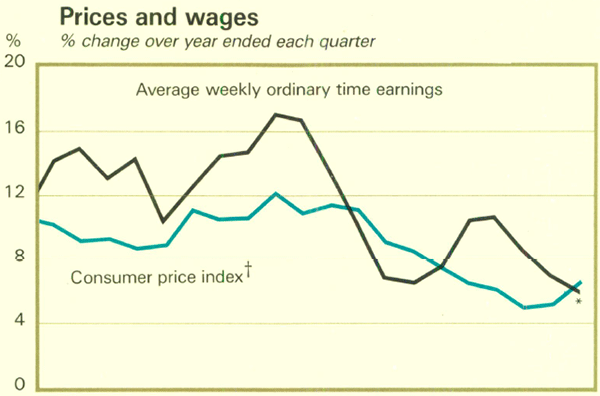
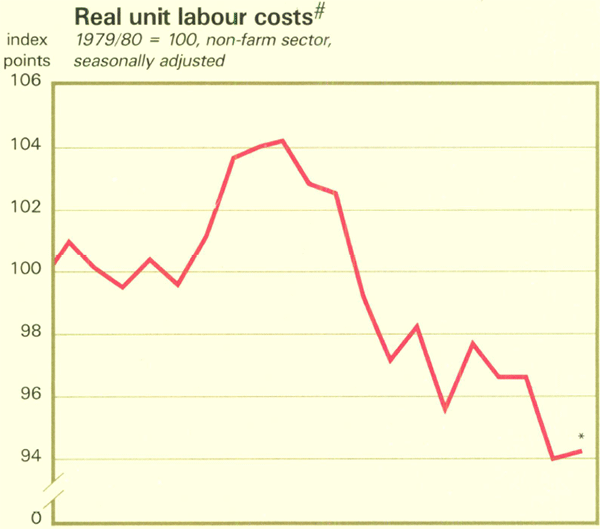
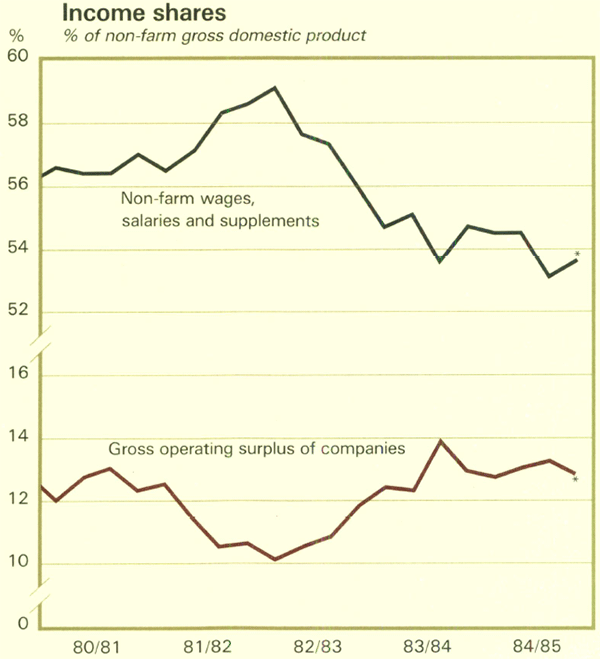
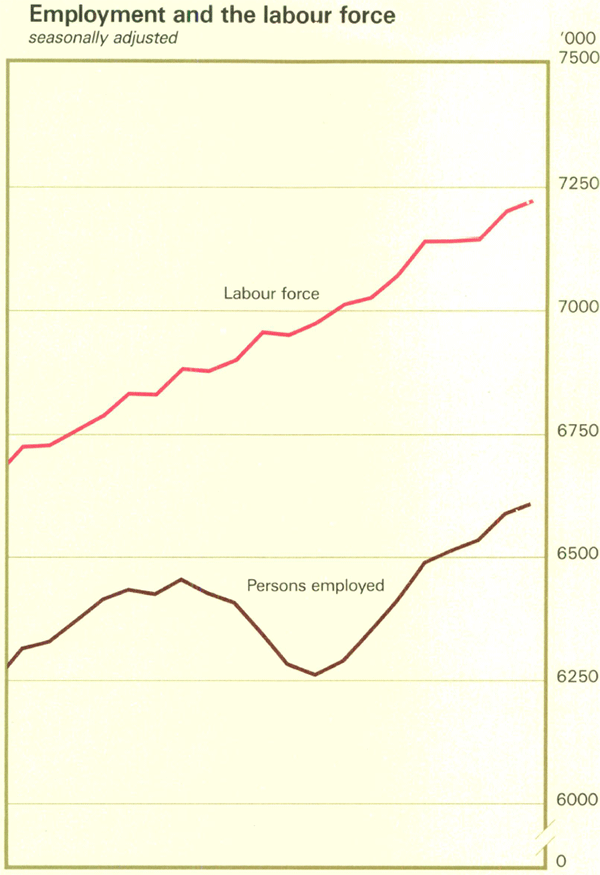
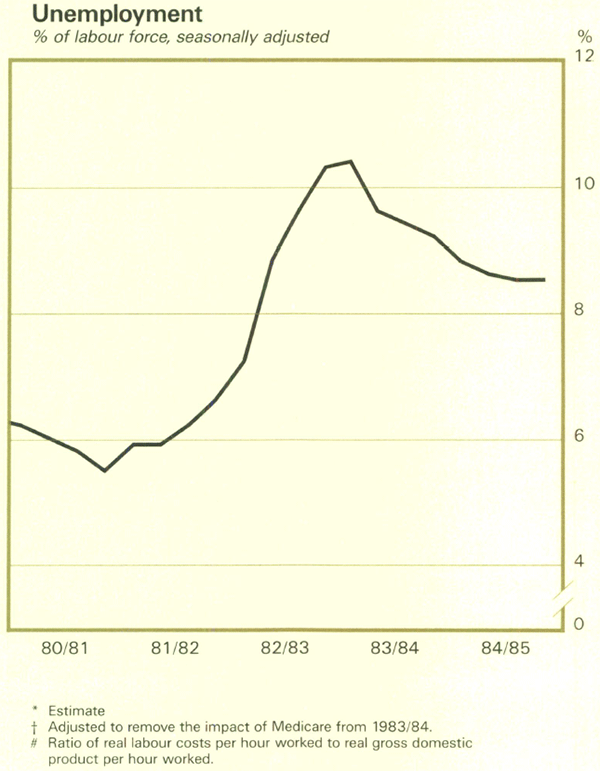
11 Production and Spending
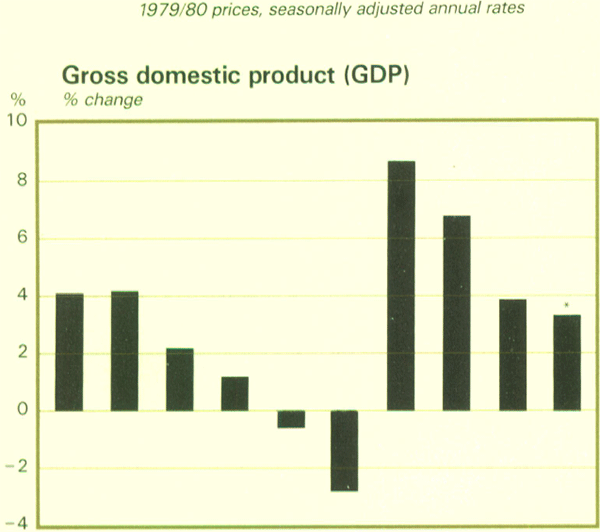
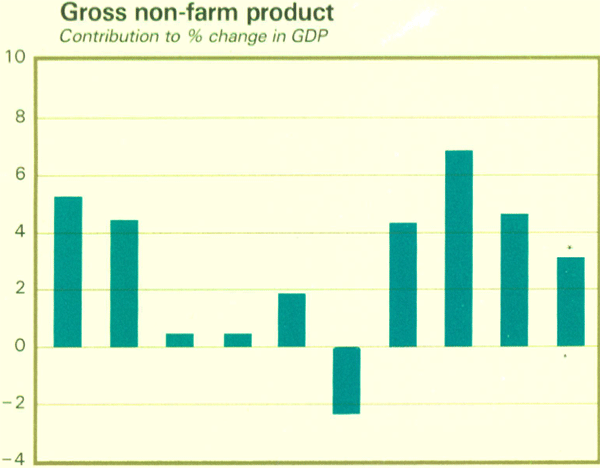
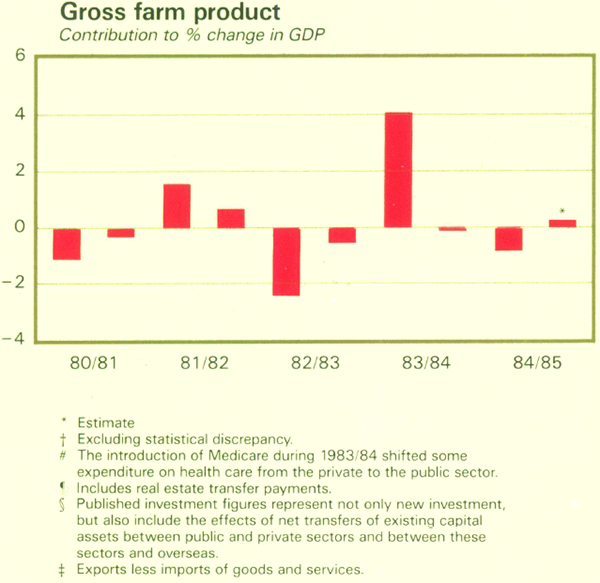
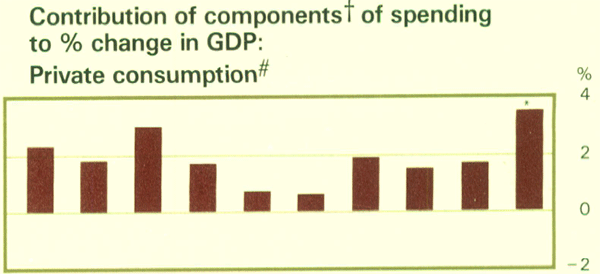

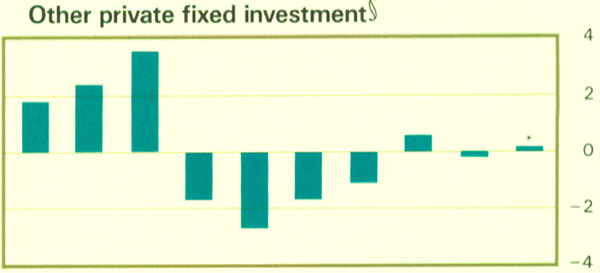
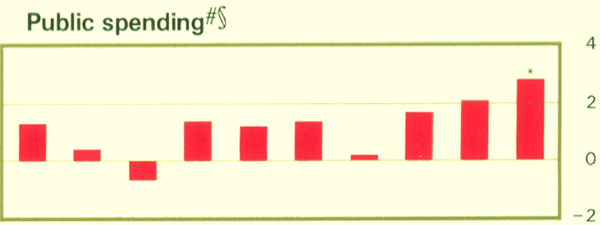
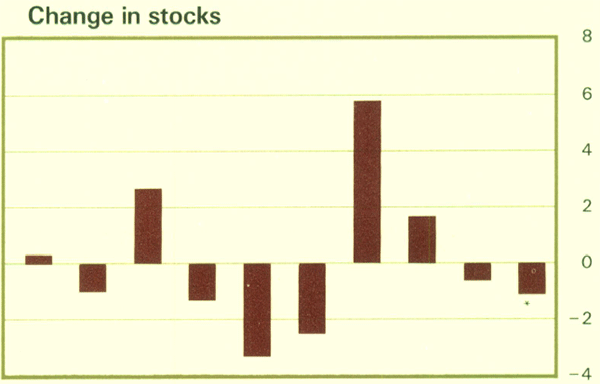
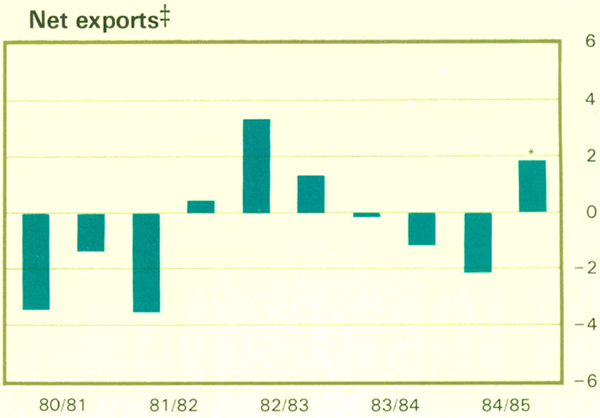
Award wages increased by 5.1 per cent in 1984/85, though only by 2.6 per cent over the course of the year. Following a small decrease in the consumer price index in the first half of 1984, the National Wage Case scheduled for September 1984 was abandoned. This meant that there were only minor adjustments to award wages between March/April 1984 and March/April 1985. Earnings continued to grow more quickly during the year than award wages. In part this reflected an increase in overtime hours worked and compositional effects arising from the relative growth rates of different sectors of the economy. It appears also to have resulted from reclassification of jobs, and increases in rates of pay other than award increases.
Real unit labour costs fell slightly in 1984/85, reflecting further gains in productivity, which offset the small rise in real labour earnings. The reduction in costs and firmer demand added further to profitability. The gross operating surplus of companies increased again in 1984/85. The share of profits in national income rose to its highest level since the early 1970s.
The labour market
Conditions in the labour market continued to improve in 1984/85, though possibly less than might have been expected given the pace of recovery in activity after the September quarter, the reduction in real unit labour costs and the increase in profitability.
Employment increased by 2 per cent, or about 133,000 people over the year to June 1985. The pattern of growth through the year was erratic, with the larger part of the increase occurring in the second half of the year. Full-time jobs accounted for a large part of the growth in employment over the year, with female employment increasing most strongly. Total hours worked again rose strongly, as did average weekly overtime. Job vacancies also increased sharply during 1984/85.
In the early stages of the current recovery in activity (starting around mid 1983), employment growth was dominated by the public sector. With the recovery broadening in 1984/85, the sources of new jobs also broadened. An exception was manufacturing where, despite a strong increase in overtime hours worked, employment declined.
The participation rate (employed plus unemployed civilians as a proportion of total population of working age) declined over the second half of 1984 but, in the first half of 1985, returned to a little below the level at which it started the financial year. The labour force grew by 1.5 per cent during the year, following similar increases in recent years.
12 Balance of Payments
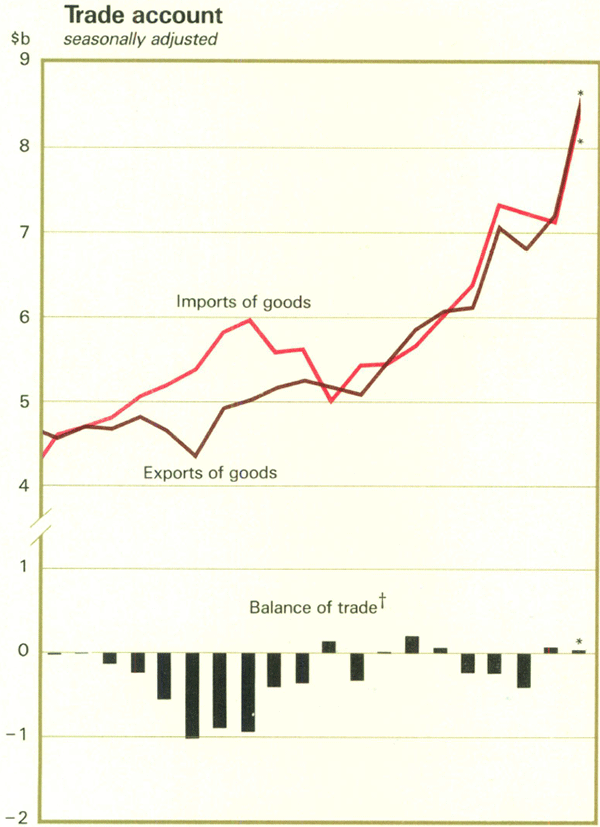
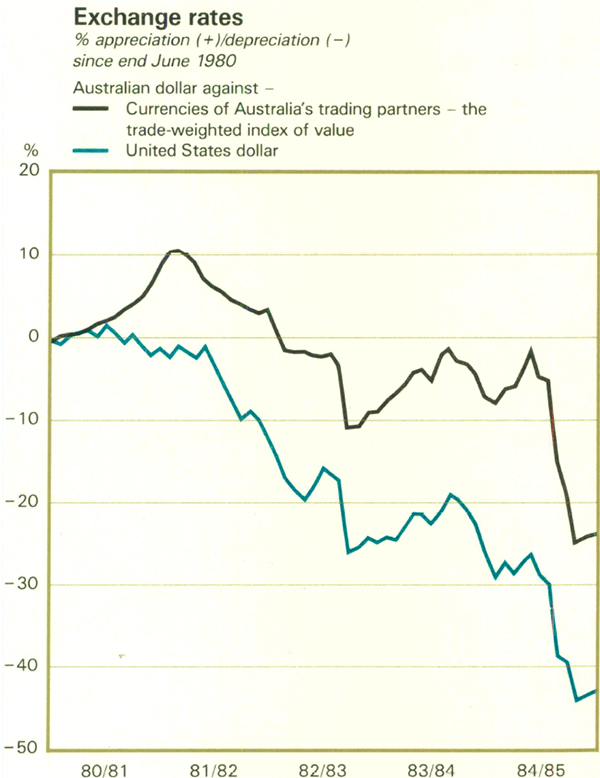
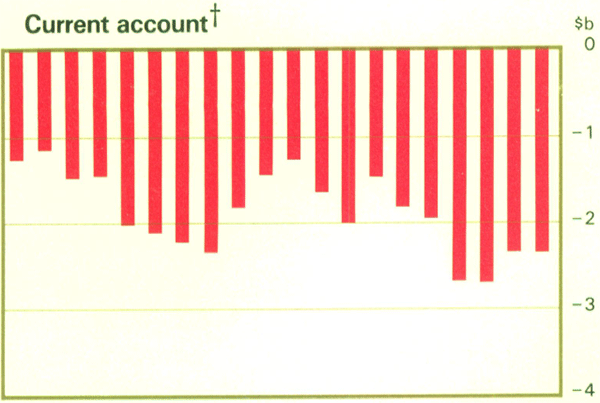
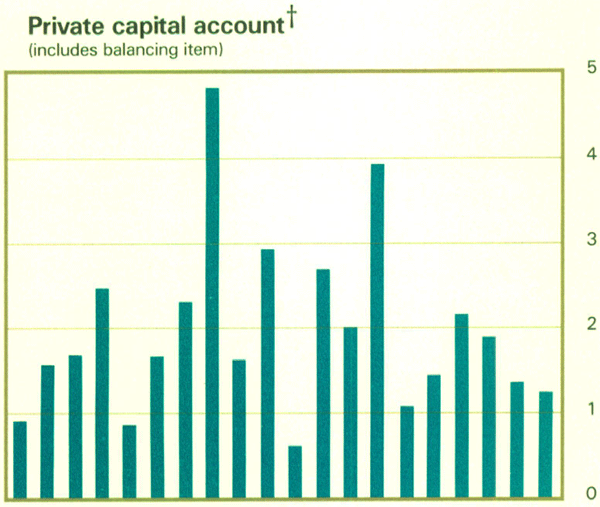
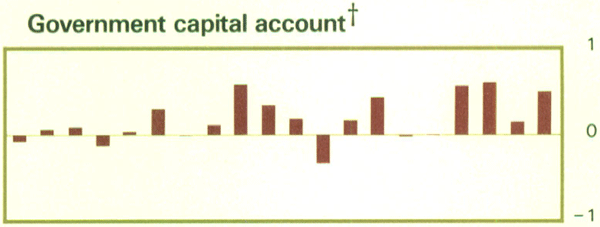
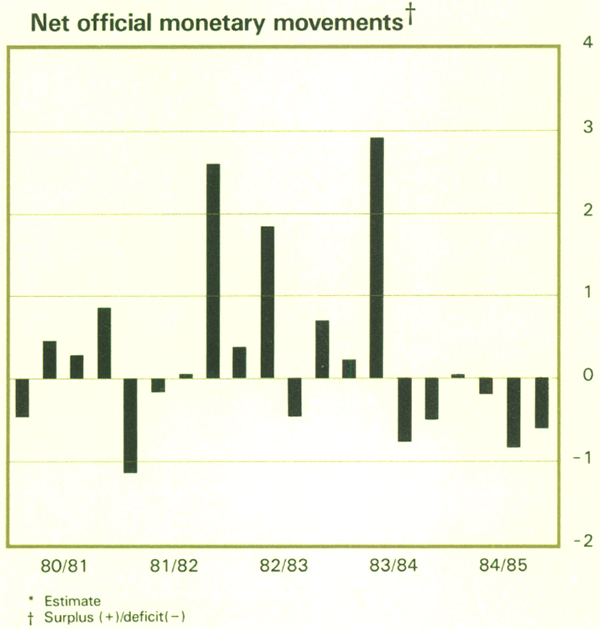
With the labour force growing more slowly than employment, the number of unemployed declined by over 40,000 to 616,500 in the June quarter 1985. The rate of unemployment declined from 9.2 per cent in the June quarter 1984 to 8.5 per cent in the June quarter 1985.
The balance of payments
The striking feature of Australia's external accounts in 1984/85 was the deficit on current account of around $10,150 million. This was about $2,850 million higher than the deficit in 1983/84 and just under 5 per cent of GDP. It was also considerably larger than expected at Budget time. The deficit reflected a worsening in the balance of trade, as well as a sharp rise in the deficit on invisibles. Prospects for a longer-term decline in the deficit were boosted by the depreciation of the Australian dollar in the first half of 1985. While the depreciation appeared to increase both import and export prices in the first half of 1985, the full impact on import and export volumes will take time. Consequently, the net impact on the trade deficit in 1984/85 is likely to have been minor.
The volume of exports increased strongly by an estimated 15 per cent in 1984/85, following a rise of around 8 per cent in 1983/84. Rural and non-rural exports both contributed. Following good harvests in 1983/84 and a large carryover of stocks, exports of cereals made a major contribution to growth in total exports. Impetus also came from increased exports of wool. The increase in non-rural exports was dominated by coal. Contributions also came from aluminium-related industries and surplus crude oil production. World prices were generally subdued for both rural and non-rural exports. The depreciation of the Australian dollar, however, boosted the value of exports in domestic currency to an overall increase of around 25 per cent in 1984/85.
The volume of imports increased by an estimated 16 per cent in 1984/85. With inflation in Australia's major trading partners generally low, the increase in import prices was largely the result of the movement in the Australian dollar; the value of imports increased by 28 per cent in 1984/85. While demand for imports was influenced by the recovery in domestic activity generally, imports of investment goods were particularly strong. The rise in import volumes relative to domestic demand also appears to have been influenced by the lagged effects of the earlier decline in international competitiveness.
Despite the strong performance of exports, the trade account moved into deficit in 1984/85, following a small surplus in 1983/84. The consequent widening of the current account deficit was accentuated by a marked increase in the deficit on invisibles. Factors contributing to the latter included: higher interest payments on external debt; higher freight payments associated with the increase in trade volumes; and a higher level of investment income payable abroad due to improved domestic profitability.
Net capital inflow in 1984/85 was around $8,540 million, about $600 million less than in the preceding year. The Commonwealth raised $1,850 million, increasing its share of the total to 22 per cent, compared with 7 per cent a year earlier. Public non-monetary enterprises raised $2,920 million and the remaining $3,770 million was raised by the private sector. The greater part of private inflow was in the form of borrowings.
Measured in Australian dollars, Australia's estimated gross external debt rose sharply from around $45 billion (24 per cent of GDP) in June 1984 to around $67 billion (32 per cent of GDP) by June 1985. A little less than half this increase resulted from debt accumulation in 1984/85; the remainder reflected depreciation of the Australian dollar against the currencies in which Australia's debts are denominated. Australia's balance of payments (the difference between the current and capital accounts), as measured by net official monetary movements, recorded an overall deficit of $1,605 million in 1984/85.
Australia's international reserves, including valuation effects, increased by $1,100 million over the course of 1984/85 to $13,517 million. The increase was more than accounted for by revaluation of reserves due to depreciation of the Australian dollar. Measured in U.S. dollars, reserves fell by almost 16 per cent from US$10,695 million in June 1984 to US$8,995 million in June 1985. This mainly reflected sales of foreign currency to the Commonwealth to meet its foreign exchange requirements and the Bank's smoothing and testing operations in the foreign exchange market.
Footnotes
*A half-yearly review of economic and financial conditions in Australia and abroad appeared in the March 1985 issue of the Bank's Bulletin. A review of external conditions appeared in the July 1985 issue. [1]
†Figures in this chapter include estimates based on data available at the time of writing. [2]